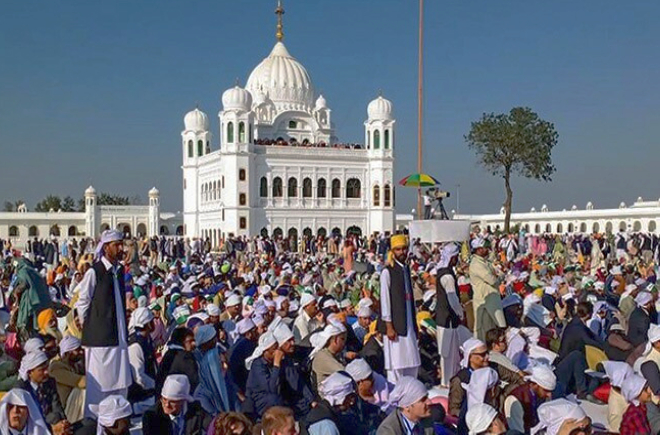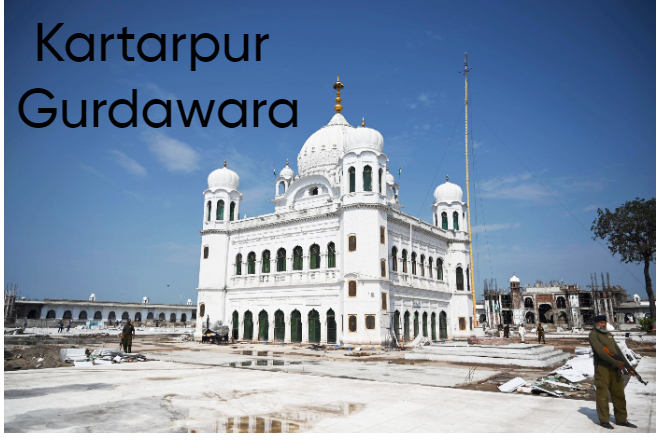Kartarpur Corridor An important Cross-Border Pilgrim

Kartarpur, also known as Kartarpur Sahib, holds great significance in Sikhism and serves as a place of deep religious and historical importance. It is a town located in the Narowal District of the Punjab province in Pakistan, near the India-Pakistan border. The primary attraction in Kartarpur is the Gurdwara Darbar Sahib, also called Kartarpur Sahib Gurdwara. Here are some key aspects of Kartarpur and its historical and cultural significance:
1. Birthplace of Sikhism: Kartarpur is revered as the place where Guru Nanak Dev Ji, the founder of Sikhism, spent the last 18 years of his life. He settled in Kartarpur after his extensive travels and established a community there. Guru Nanak’s teachings formed the foundation of Sikhism, emphasizing equality, social justice, and devotion to one God.
2. Gurdwara Darbar Sahib: The Gurdwara in Kartarpur is one of the holiest sites for Sikhs worldwide. It was built at the location where Guru Nanak Dev Ji’s dwelling once stood. The Gurdwara is an impressive architectural marvel, with a large prayer hall and a beautiful white facade. It attracts thousands of pilgrims and tourists, both Sikh and non-Sikh, every year.

3. Historical Significance: Kartarpur is historically significant as it marks the place where Guru Nanak Dev Ji initiated the practice of “Langar,” a free community kitchen providing food to people of all backgrounds and religions. This practice symbolizes equality and selfless service and remains an integral part of Sikhism today.
4. Cross-Border Pilgrimage: Kartarpur gained international attention due to its location near the India-Pakistan border. In November 2019, a historic development took place when the Kartarpur Corridor was inaugurated, allowing Sikh pilgrims from India to visit the Kartarpur Gurdwara without needing a visa. This corridor served as a bridge of peace between the two neighboring countries and facilitated religious tourism.
5. Tourist Attraction: Kartarpur has become a significant tourist destination, drawing visitors not only for its religious importance but also for its serene and peaceful environment. The picturesque surroundings of the Gurdwara, along with the peaceful banks of the Ravi River, provide a tranquil atmosphere for reflection and meditation.
6. Cultural Heritage: The town of Kartarpur reflects the rich cultural heritage of the Punjab region. Visitors can experience Punjabi cuisine, traditional music, and colorful attire when exploring the local culture and traditions.
Kartarpur Corridor; An important Cross Border Pilgrimage
The Kartarpur Corridor, connecting the Gurdwara Darbar Sahib in Kartarpur, Pakistan, to the Indian border, holds several cross-border and international significance. The Corridor facilitates the easy movement of Sikh pilgrims from India to the Kartarpur Gurdwara in Pakistan. This has allowed Sikhs to undertake religious pilgrimages to a site of great historical and spiritual importance, strengthening their connection to their faith and heritage. The opening of the Kartarpur Corridor is seen as a symbol of peace and goodwill between India and Pakistan. Despite historical tensions and conflicts, it demonstrates the potential for cooperation and people-to-people contact. The corridor represents a diplomatic effort to build bridges and foster peaceful relations.
The corridor promotes cultural exchange between India and Pakistan. Visitors from both sides can experience the cultural and historical heritage of the Punjab region. This exchange fosters a better understanding of each other’s traditions, languages, music, and cuisine, promoting cross-border cultural ties. The Kartarpur Corridor has boosted tourism in the region, benefiting local businesses and economies on both sides of the border. Hotels, restaurants, and souvenir shops near the corridor have seen increased business, contributing to the economic growth of the surrounding areas.

The corridor allows people from India and Pakistan to interact peacefully and harmoniously. Pilgrims and visitors can meet and engage with individuals from across the border, promoting understanding and goodwill at the grassroots level. The Kartarpur Corridor provides a channel for diplomatic communication between India and Pakistan. It serves as an example of constructive dialogue and cooperation, demonstrating that both countries can work together on common goals, even in the face of broader political challenges. The corridor has made it easier for elderly and ailing pilgrims to visit the Kartarpur Gurdwara, as it eliminates the need for complex visa procedures and reduces travel hardships. This has been seen as a humanitarian gesture, allowing individuals to connect with their religious heritage more easily.
The Kartarpur Corridor has multifaceted cross-border importance, spanning religious, diplomatic, cultural, economic, and humanitarian dimensions. It has the potential to foster better relations between India and Pakistan while promoting peace, understanding, and cooperation in the region.
Historical Significance of Kartarpur
The history of Kartarpur is deeply intertwined with the life and teachings of Guru Nanak Dev Ji, the founder of Sikhism. Guru Nanak Dev Ji, born in 1469 in the village of Talwandi (now known as Nankana Sahib in Pakistan), traveled extensively to spread his message of monotheism, equality, and devotion to God. After his travels, Guru Nanak settled in Kartarpur in 1522 and spent the last 18 years of his life there. He established a community around him and continued to preach his teachings.
Guru Nanak’s dwelling in Kartarpur became a center for Sikh congregations, and a simple Gurdwara (Sikh place of worship) was constructed there. This Gurdwara, later known as Gurdwara Darbar Sahib, was the place where Guru Nanak Dev Ji held his daily congregations, or “satsangs,” and delivered spiritual discourses to his followers. During his time in Kartarpur, Guru Nanak Dev Ji emphasized the importance of living a truthful and righteous life, serving humanity, and meditating on God’s name. His teachings formed the foundation of Sikhism and laid the groundwork for the Sikh way of life, including the principles of humility, equality, and selfless service.
In Kartarpur, Guru Nanak established the practice of “Langar,” a free community kitchen that provided food to all, regardless of their caste, creed, or social status. This tradition exemplified the Sikh principles of equality and selfless service. The concept of Langar continues to be an integral part of Sikh Gurdwaras worldwide. Guru Nanak Dev Ji passed away in Kartarpur on September 22, 1539. His followers, known as Sikhs, continued to gather at Kartarpur and preserved his teachings. Guru Nanak’s spiritual successor, Guru Angad Dev Ji, further nurtured the Sikh community in Kartarpur.

Kartarpur remained a place of Sikh pilgrimage even after the partition of India and Pakistan in 1947. However, access to Kartarpur became a challenge due to the border between the two countries. In November 2019, the Kartarpur Corridor was inaugurated, allowing Sikh pilgrims from India to visit Kartarpur Gurdwara in Pakistan without requiring a visa, marking a significant development in the history of Kartarpur.
Today, Kartarpur stands as a symbol of Guru Nanak Dev Ji’s teachings and serves as a place of reverence and pilgrimage for Sikhs from around the world. It also represents a bridge of peace and cultural exchange between India and Pakistan through the Kartarpur Corridor, fostering goodwill and religious tourism.

